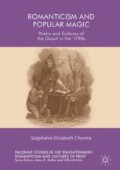Abstract
The conclusion summarises the achievements of the study, and what it has revealed about the influence of material cultures of popular magic on Romanticism’s imaginative literature when read with the newly excavated evidence provided by social historians firmly in mind. It also provides a brief glimpse into how each writer represented magic in their later works. Thelwall’s deployment of the occult transformed into a new form that suited his newly forged identity of elocutionist, Wordsworth’s ‘Ecclesiastical Sonnets’ signalled a departure from magic as a socially levelling force and agent of social justice, Coleridge once again drew connotations between popular magic and unthinking radicalism in The Friend, and Southey continued to find the occult (both oriental, and domestic) irresistibly alluring in The Curse of Kehama.
Access this chapter
Tax calculation will be finalised at checkout
Purchases are for personal use only
Notes
- 1.
John Thelwall, ‘Mr Thelwall’s Lecture on the Elements of Euphony’, John Thelwall Selected Poetry and Poetics, ed. Judith Thompson (Hampshire: Palgrave Macmillan, 2015), 207–13, 208.
- 2.
Perched on the north-western slopes of the Harz Mountains, Goslar is famed for its connections to witchcraft and magic. The town is cast in the shadow of the Brocken Mountain, home to the mysterious Brocken Spectre – a natural light phenomenon that reflects walker’s shadows upon the mist, creating a doubled projection. The spectre attracted Romantic writers who were interested in the uncanny and constructions of the self. In 1777, Goethe climbed the Brocken for inspiration for what would become ‘Faust’.
- 3.
Williams, William Wordsworth : A Literary Life (Hampshire, Macmillan Press, 1996), 106.
- 4.
Anne L. Rylestone, Prophetic Memory in Wordsworth’s Ecclesiastical Sonnets (Carbondale: Southern Illinois University Press, 1991), 3. See also Edward Davies, The Mythology and Rites of the British Druids (London: J. Booth, 1809), 87.
- 5.
Rylestone, Prophetic Memory, xvii.
- 6.
William Wordsworth, ‘Ecclesiastical Sonnets Part II: XI Transubstantiation’, The Poetical Works of William Wordsworth, second edition, ed. E. De Selincourt and Helen Darbishire (Oxford: Oxford University Press, 1940), III, l. 6.
- 7.
William Wordsworth, ‘Ecclesiastical Sonnets Part I: XXXIX Papal Dominion’, The Poetical Works of William Wordsworth, second edition, ed. E. De Selincourt and Helen Darbishire (Oxford: Oxford University Press, 1940), III, ll. 10–4.
- 8.
William Wordsworth, ‘Ecclesiastical Sonnets Part I: XXVIII Influence Abused’, The Poetical Works of William Wordsworth, second edition, ed. E. De Selincourt and Helen Darbishire (Oxford: Oxford University Press, 1940), III, l. 14.
- 9.
Wordsworth, ‘Influence Abused’, l. 5.
- 10.
Samuel Taylor Coleridge, The Collected Works of Samuel Taylor Coleridge: The Friend, ed. Barbara E. Rooke (London: Routledge & Kegan Paul, 1969), I, 56.
- 11.
Coleridge, The Friend, I, 57.
- 12.
Ibid.
- 13.
Ibid., 59.
- 14.
Ibid., 60.
- 15.
Coleridge, Biographia Literaria , 181.
- 16.
Ibid., 30.
- 17.
Ibid., 197.
- 18.
Coleridge, The Friend, 144.
- 19.
Ibid., 145.
- 20.
Ibid.
- 21.
Robert Southey, The Curse of Kehama : Robert Southey: Poetical Works 1793–1810, ed. Daniel Sanjiv Roberts (London: Pickering and Chatto, 2004), 3.
- 22.
Southey, Kehama , Book XI, ll. 27–9.
- 23.
Ibid., l. 49.
- 24.
Ibid., 238–4.
- 25.
Ibid., 91, n.d.
- 26.
Caroline Franklin, ‘“Monstrous combinations of horrors and mockery”? Southey, Catholicism and the Gothic’, Romanticism, 17.1 (2011), 25–38, 25.
- 27.
Robert Southey, All for Love and the Pilgrim to Compostella (London, John Murray, 1829).
Author information
Authors and Affiliations
Rights and permissions
Copyright information
© 2019 The Author(s)
About this chapter
Cite this chapter
Churms, S.E. (2019). Conclusion. In: Romanticism and Popular Magic. Palgrave Studies in the Enlightenment, Romanticism and Cultures of Print. Palgrave Macmillan, Cham. https://doi.org/10.1007/978-3-030-04810-5_8
Download citation
DOI: https://doi.org/10.1007/978-3-030-04810-5_8
Published:
Publisher Name: Palgrave Macmillan, Cham
Print ISBN: 978-3-030-04809-9
Online ISBN: 978-3-030-04810-5
eBook Packages: Literature, Cultural and Media StudiesLiterature, Cultural and Media Studies (R0)

